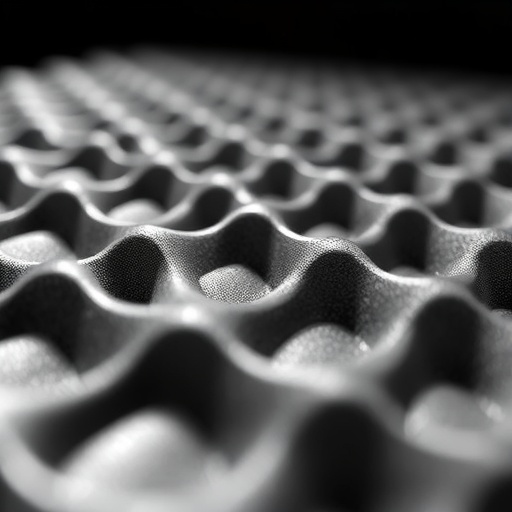In a groundbreaking advance set to redefine how we manipulate sound and vibrations, researchers at the Advanced Science Research Center at the CUNY Graduate Center have unveiled a revolutionary approach dubbed “twistelastics.” Inspired by the emergent field of twistronics—which has transformed electronic devices by controlling electron flow through twisting layered materials—this novel technique harnesses the power of twisting engineered elastic surfaces to control mechanical wave propagation with unprecedented precision and flexibility.
Traditional methods of controlling acoustic waves and vibrations rely on fixed structural designs, which restrict adaptability and limit performance, particularly in technologies like ultrasound imaging, microelectronics, and advanced sensors. The twistelastics approach sidesteps these limitations by introducing minute angular rotations between two identically patterned metasurfaces. These metasurfaces, fabricated with microscopic pillar arrays using cutting-edge 3D printing technologies, interact in complex ways depending on their relative twist angle, enabling engineers to dynamically tune wave behavior in real-time.
The crux of this discovery lies in exploiting the topological transitions induced by twisting. As the two metasurfaces rotate relative to each other, their combined elastic environment undergoes profound changes that govern vibrational pathways. At a specific “magic angle,” mechanical waves become intensely focused and channeled along predefined trajectories, presenting a new paradigm for guiding elastic energy with ultra-high fidelity. This sharply contrasts with conventional metasurfaces where wave guidance is static and limited in bandwidth.
Andrea Alù, Einstein and Distinguished Professor of Physics and founding director of the Photonics Initiative at CUNY ASRC, explains that “the elegance of twistelastics is in its simplicity; by merely rotating two layers, we open a spectrum of controllable wave propagation phenomena that were previously inaccessible.” The adaptability embedded in this approach promises to unlock radical improvements in signal processing speed and efficiency, potentially transforming telecommunications, acoustic sensing, and medical diagnostic technologies.
From a theoretical perspective, the research integrates principles of wave mechanics with topological physics, revealing how rotational degrees of freedom between layers modulate the band structure of elastic waves. Computer simulations based on advanced models of elastodynamics guided prototype fabrication. These 3D-printed metasurfaces incorporate meticulously engineered microscopic pillars that serve as scattering centers, whose relative configuration under twisting orchestrates wave scattering and interference in tunable and reversible ways.
Experimentally, the team demonstrated that the composite twisted metasurfaces facilitate broadband control over wave modes across a wide frequency range, accommodating diverse application needs. Unlike conventional approaches that suffer from performance loss due to fabrication inconsistencies, the twistelastic system inherently mitigates such defects due to topological robustness, ensuring sustained wave guidance even in imperfect practical implementations.
One of the most compelling outcomes of this research is the potential miniaturization of twistelastic structures for chip-scale devices. Such compact platforms could enable integration into modern microelectronic architectures, offering dynamic acoustic control in ultrathin layers—a feat that could revolutionize consumer electronics, wearable medical devices, and microfluidic systems by enabling real-time reconfigurable vibration management at the nanoscale.
Moreover, the capacity to tune mechanical wave propagation dynamically encourages new vistas in non-invasive medical imaging. Ultrasound systems could leverage twistelastics to adapt their acoustic profiles instantly, achieving higher-resolution images while minimizing energy consumption. Similarly, sensor devices across industrial and environmental settings could become significantly more sensitive and selective in detecting structural faults or subtle physicochemical changes.
The interdisciplinary team behind this innovation combined expertise in nanoscience, photonics, and classical mechanics to translate complex theoretical models into tangible physical systems. Their collaborative environment fostered rapid iteration between simulation and experimentation, exemplifying how modern research ecosystems accelerate technological breakthroughs through cross-pollination of knowledge and methodologies.
As the research community digests the implications of twistelastics, attention is already focused on expanding the foundational principles to other types of mechanical waves, including elastic shear and surface acoustic waves. Exploring the integration of twistelastic metasurfaces with electromagnetic metamaterials might also lead to hybrid devices capable of simultaneously manipulating multiple wave modalities, heralding new multi-functional smart materials.
This seminal work, published in the Proceedings of the National Academy of Sciences in October 2025, marks a promising leap toward widespread practical applications in technologies where controlling mechanical waves is pivotal. By bringing the dynamic prowess of twistronics to the realm of elastodynamics, twistelastics opens a versatile toolbox for engineers and physicists eager to push the frontiers of wave manipulation, promising an era where acoustic and vibrational waves can be shaped with the same elegance and flexibility as light or electrons.
The essence of twistelastics lies not only in its technical sophistication but also in its potential societal impact. From enhancing the resolution of everyday medical diagnostics to bolstering the reliability of microelectromechanical systems embedded in consumer products, this transformative technology stands to influence a broad spectrum of sectors. Its ability to enable rapid reconfiguration and resilience against imperfections positions it as a cornerstone of the next generation of elastic metamaterials.
With continued research and development, twistelastics may soon transcend laboratory settings, paving the way for smart materials and devices where on-demand control of sound and vibration becomes as routine as tuning a radio. As industries seek ever more efficient ways to harness waves for communication, sensing, and imaging, the twistelastic paradigm promises to be a game-changer in designing adaptive, responsive, and robust wave-based technologies for the future.
Subject of Research: Not applicable
Article Title: Broadband topological transitions in twisted elastodynamic metasurfaces
News Publication Date: 13-Oct-2025
Web References:
https://doi.org/10.1073/pnas.2427049122
References:
Andrea Alù et al., “Broadband topological transitions in twisted elastodynamic metasurfaces,” Proceedings of the National Academy of Sciences, October 13, 2025.
Image Credits:
Andrea Alù
Keywords
Metasurfaces, Mechanical energy, Wave mechanics, Acoustics, Electromagnetism




